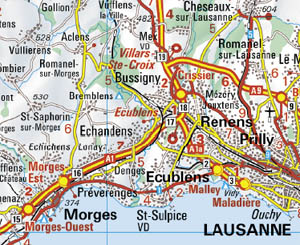|
|
|
|
|
|
Network maps
Definition
Network maps depict networks of truly existing or imagined linear objects in their spatial context. The forms of the network elements depend on the characteristics of the lines in the real world. For instance the layout of a road network is different than the layout of a river network. This has to be taken into account for the visualisation as well as for the generalisation. The symbolisation of a network is realised through the layout, the type of junctions and the interweaving as well as by the colour and form of the lines.
 Street map 1:200'000, reproduced with permission from swisstopo (BA057224) Street map 1:200'000, reproduced with permission from swisstopo (BA057224) |
Opposite street map is an example of a network map. |
Network types
There is a variety of network systems that can be depicted as network maps. The most common and most important ones are listed as follows (c.f. (Imhof 1972, p. 109)):
- Network of supporting, construction and measurement lines
Map grids, triangulation diagrams, radar networks, networks of line-of-sights and influence line fall in this category. - Networks resulting from the generalisation of area objects
Examples are river networks, networks of paths, railway networks and supply networks. Also imagined networks like ship routes, travel routes or lines of fire fall in this category. - Boundary lines
This category includes property boundaries, political boundaries and language boundaries. This kind of network is often used but the focus of such maps lies mostly on the areas which are limited by the boundaries and not on the boundaries itself. - Value, iso and gradient lines
These kinds of networks are used to visualise continua. They represent a special case within network visualisations and are therefore explained in a subsequent section.
The following animation shows different examples of network visualisations of
the above mentioned network types.
